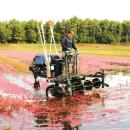Cranberry bonanza: Harvest season hits Hartley Family Farm
 Cranberries are wet-harvested from bogs at the Hartley Family Farm. Photos by Grace Ann Natanawan
Cranberries are wet-harvested from bogs at the Hartley Family Farm. Photos by Grace Ann Natanawan Rochester farmer Woody Hartley stands next to a batch of harvested cranberries.
Rochester farmer Woody Hartley stands next to a batch of harvested cranberries. Hartley plucks fresh cranberries straight from the vine.
Hartley plucks fresh cranberries straight from the vine. Hartley sits at a sorting station where he individually analyzes each dry-harvested cranberry.
Hartley sits at a sorting station where he individually analyzes each dry-harvested cranberry. Wet-harvested cranberries are separated from their vines using a mechanical process.
Wet-harvested cranberries are separated from their vines using a mechanical process. Dry-harvested cranberries at the Hartley Family Farm.
Dry-harvested cranberries at the Hartley Family Farm. The bogs are flooded with water to begin the harvesting process.
The bogs are flooded with water to begin the harvesting process. Hartley examines a vintage dry-picking device.
Hartley examines a vintage dry-picking device.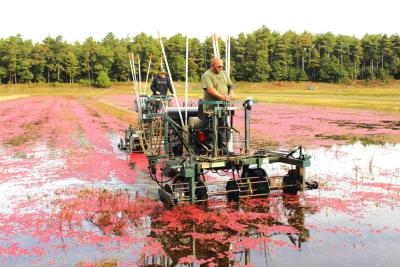 Cranberries are wet-harvested from bogs at the Hartley Family Farm. Photos by Grace Ann Natanawan
Cranberries are wet-harvested from bogs at the Hartley Family Farm. Photos by Grace Ann Natanawan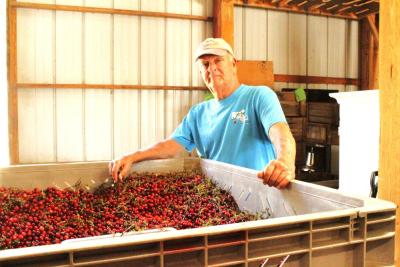 Rochester farmer Woody Hartley stands next to a batch of harvested cranberries.
Rochester farmer Woody Hartley stands next to a batch of harvested cranberries.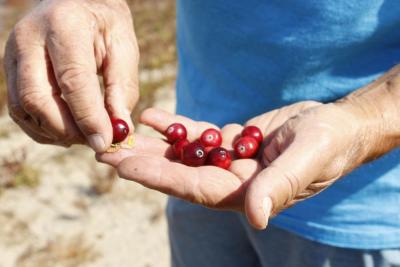 Hartley plucks fresh cranberries straight from the vine.
Hartley plucks fresh cranberries straight from the vine. Hartley sits at a sorting station where he individually analyzes each dry-harvested cranberry.
Hartley sits at a sorting station where he individually analyzes each dry-harvested cranberry.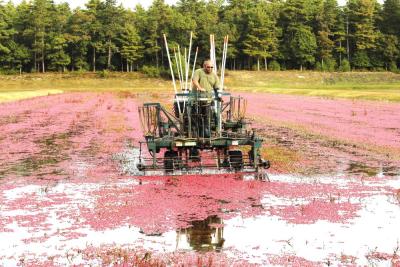 Wet-harvested cranberries are separated from their vines using a mechanical process.
Wet-harvested cranberries are separated from their vines using a mechanical process.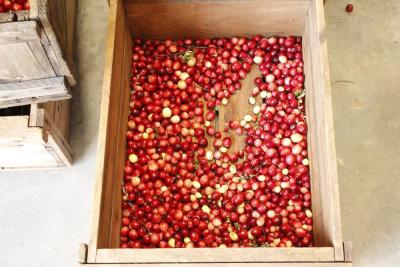 Dry-harvested cranberries at the Hartley Family Farm.
Dry-harvested cranberries at the Hartley Family Farm. The bogs are flooded with water to begin the harvesting process.
The bogs are flooded with water to begin the harvesting process. Hartley examines a vintage dry-picking device.
Hartley examines a vintage dry-picking device.ROCHESTER — With over 11 acres of bogs, three varieties of cranberries and two brothers at the helm of the operation, the Hartley Family Farm began their 24th harvest season in Rochester after a summer of preparation.
Located in Rochester, former six-year Selectman and farmer Woody Hartley grew up on the land that would later be transformed into cranberry bogs. The process of clearing woodlands and building the bogs took six years, starting in 1995 and ending in 2001.
“I quit my job and I worked there every day,” said Hartley, who previously worked for the Massachusetts Environmental Protection Agency, the Department of Environmental Protection and in engineering.
“There’s a whole different career that I’ve been doing for about 25 years,” he added.
Three varieties of cranberries are grown at the farm: Stevens, Howes and Haines.
“A lot of people have one variety or two. We have three — trying to be a diverse, small farm. You have to be diverse to make any money,” said Hartley.
The cranberry plant is a perennial, meaning they grow every year after being planted.
Half the bogs at the Hartley Farm are Stevens variety, which was developed in the mid-1990s through crossbreeding.
Hartley said they are “the best variety to make sweet dried cranberries because of their shape, size and color.”
Howes Cranberries are native to Massachusetts and have been harvested for over 100 years.
Cranberries are either dry-harvested or wet-harvested from the bogs. Using the wet-harvest method, farmers flood the bog and use machines to separate the berries from the vines in the water, causing the berries to float to the surface to be collected.
Dry-harvested cranberries are not flooded, and the berries are plucked straight from the vines using a mechanical harvester.
Plucking fresh red cranberries from a vine, Hartley held them in his hand and explained that “you can pick this now and just keep this in a cool, dry place and in a month or two, they’ll still look just like this. They won’t rot or anything.”
The Haines variety cranberry was developed by crossbreading at Rutgers University, which Hartley described as “one of the leading research facilities for developing new cranberries.”
Around 75% of the cranberries are sold to Decas Cranberry Products, which was acquired by Canadian cranberry and blueberry supplier Fruit d’Or in 2021. The wet-harvested fruit is sent to the supplier’s Carver facility and made into sweet dried cranberries.
The Howes variety are retailed by the farm itself. Local markets such as Fieldstone Market in Marion and Friends Marketplace in Rochester buy the berry straight from the Hartley family.
To separate the premiere cranberries from the damaged fruit, the farm utilizes a sorting machine built in the 1920s that also filters out rocks and debris from the dry-harvest.
“The good ones bounce off the board. The bad ones don’t bounce — the soft body ones — and the stones,” said Hartley.
After the cranberries are processed by the machine, Hartley and his brother Walter sit at a sorting station and look at the individual berries to check their quality.
With the effects of climate change intensifying each year, Hartley stated the price of farming is continuing to increase.
“Climate change has been a big issue for us,” he said. “The cranberry season is longer now.”
The berries have started growing earlier due to warmer temperatures and they don’t get ripe as early as they used to because of the changing weather patterns, according to Hartley.
“The year is becoming longer — and when the year becomes longer, it costs more,” he explained.
Hartley’s greatest joy in working on the farm is getting to operate a business with his family.
“Part of what I like is that I do it with my brother. We own this together [and] we work on it together — I do it with my family and his family,” he said.
The Hartley Family Farm will begin tours of their cranberry bogs on Friday, Oct. 3. Pricing and reservations are available online at https://www.cranberrybogtour.com/.



















